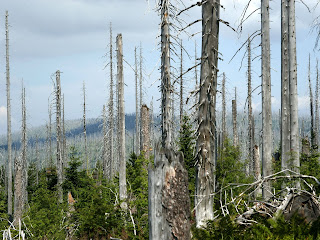The Wake up call : Acid Rains! What can we do?
Rtr. Dilhan Jayasinghe
We have been discussing the adverse effects of pollution. One of such major issue is the phenomena called Acid Rain. It is rain or a form of precipitation that is more acidic than regular, meaning that the water contains more hydrogen ions.
The causes for the increased acidity in water are gases such as sulphur and nitrogen oxides in the atmosphere. These, when mixed with oxygen and water in the atmosphere can form strong acids such as sulphuric and Nitric, which result in the increased acidity in water. The emission of sulphur and nitrogen containing gases occurs due to the burning of fossil fuels. Most of these Sulphur and Nitrogen containing gases are emitted by Electricity generations and burning of fuels in vehicles. Natural processes such as Volcanic eruptions also release such gases to the atmosphere but human activities have been the main causes especially after the industrial revolution.
 Acid rain affects almost everything. It results in the destruction of trees, soil, water and even man made statues. Acid rain can destroy the protecting film on the leaves and even stun the growth of trees. It can also affect the quality of water and soil. The composition of soil and water will be changed and the increment of acidity results in affecting the uptake of nutrients from soil. This will affect the food production of trees and in turn result in the agricultural sector. The aquatic life is also affected by the increased acidity in water and a lot of fish and other marine life cannot exist in highly acidic environments. This results in an imbalance of the ecosystem. Acid rain can also destroy statues, gravestones and monuments. The limestone buildings are deteriorated by the dissolution of limestone in acidic water.
Acid rain affects almost everything. It results in the destruction of trees, soil, water and even man made statues. Acid rain can destroy the protecting film on the leaves and even stun the growth of trees. It can also affect the quality of water and soil. The composition of soil and water will be changed and the increment of acidity results in affecting the uptake of nutrients from soil. This will affect the food production of trees and in turn result in the agricultural sector. The aquatic life is also affected by the increased acidity in water and a lot of fish and other marine life cannot exist in highly acidic environments. This results in an imbalance of the ecosystem. Acid rain can also destroy statues, gravestones and monuments. The limestone buildings are deteriorated by the dissolution of limestone in acidic water.
The answers for these global questions to be completely solved, can be far from reach in the practical world, but there are ways of reducing the causes of Acid rain. Purification of petroleum fuels by removing sulphur contents to a greater extent can minimize the production of acids in atmosphere. Also, the use of special catalytic methods in industrial applications can mitigate the emission of harmful nitrogen gases to the atmosphere. Other long term solutions will be the promotion of sustainable energy sources over traditional petroleum sources. Solar energy is a good alternative source. The advancement in technology made solar panels extensively popular as an alternative. Current research advancements are trying to make solar panels more efficient and economically feasible. All the alternative energy sources will have inherited pros and cons in them. Therefore, optimization of different methods for generating electricity is essential in the long run.
What can the general public do, to help reduce the acid rain?
We can certainly use public transport and reduce the burning of fossil fuels. Saving electricity starting from our own homes and workplaces can reduce the need for power generation. These can be seen as minor contributions. However, if the majority of the population can make their individual contribution, there will be a huge impact to the entire scenario.



Comments
Post a Comment